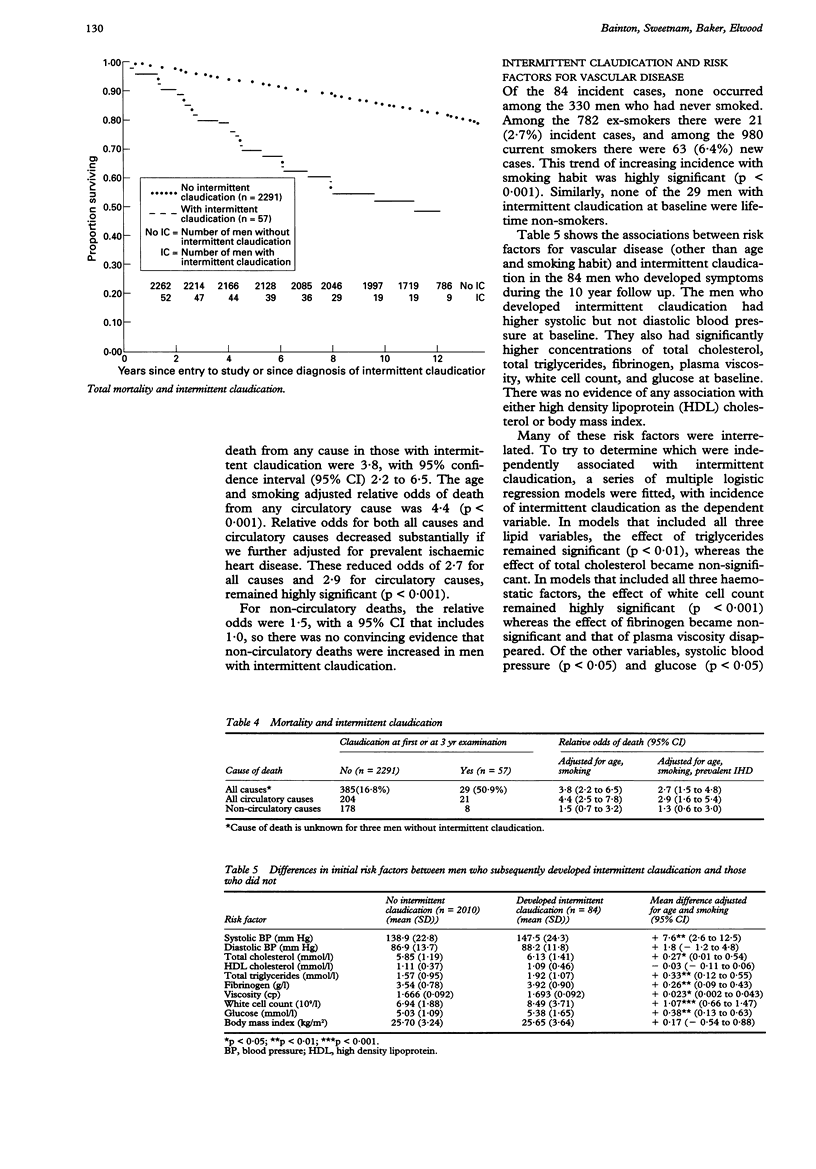Abstract
OBJECTIVE--To measure the prevalence and incidence of intermittent claudication, to describe the mortality associated wtih the condition, and to assess the relevance of risk factors for vascular disease. DESIGN--A standard questionnaire on calf pain when walking was given in the prospective Speedwell study, and a range of risk factors were measured. The men were re-examined at intervals of three years, and deaths over 11 years were identified. SETTING--The general population. PARTICIPANTS--All men aged 45 to 59 registered with 16 general practitioners. RESULTS--The prevalence of intermittent claudication increased from almost nil at ages 45-49 to 2.9% at ages 60-64. The annual incidence increased from 0.3% in the youngest men to 0.5% in those in their early 60s. Intermittent claudication was related to the existence of ischaemic heart disease, particularly angina, at the first examination. The relative odds of men with angina developing intermittent claudication was 6.7 (95% confidence interval (95% CI) 3.6 to 12.4). The risk of death in men with intermittent claudication was substantially raised. After standardisation for age and smoking the relative odds of death was 3.8 (95% CI 2.2 to 6.5). The excess was entirely from circulatory causes. Systolic blood pressure, fasting plasma glucose, triglycerides, and white cell count were all independently associated with the development of intermittent claudication, but the most striking association was with smoking. CONCLUSIONS--Intermittent claudication is an indicator for a very high risk of death. This is only partly explained by its strong association with ischaemic heart disease.
Full text
PDF




Selected References
These references are in PubMed. This may not be the complete list of references from this article.
- Bainton D., Miller N. E., Bolton C. H., Yarnell J. W., Sweetnam P. M., Baker I. A., Lewis B., Elwood P. C. Plasma triglyceride and high density lipoprotein cholesterol as predictors of ischaemic heart disease in British men. The Caerphilly and Speedwell Collaborative Heart Disease Studies. Br Heart J. 1992 Jul;68(1):60–66. doi: 10.1136/hrt.68.7.60. [DOI] [PMC free article] [PubMed] [Google Scholar]
- Criqui M. H., Langer R. D., Fronek A., Feigelson H. S., Klauber M. R., McCann T. J., Browner D. Mortality over a period of 10 years in patients with peripheral arterial disease. N Engl J Med. 1992 Feb 6;326(6):381–386. doi: 10.1056/NEJM199202063260605. [DOI] [PubMed] [Google Scholar]
- Fowkes F. G., Housley E., Cawood E. H., Macintyre C. C., Ruckley C. V., Prescott R. J. Edinburgh Artery Study: prevalence of asymptomatic and symptomatic peripheral arterial disease in the general population. Int J Epidemiol. 1991 Jun;20(2):384–392. doi: 10.1093/ije/20.2.384. [DOI] [PubMed] [Google Scholar]
- Fowkes F. G., Housley E., Riemersma R. A., Macintyre C. C., Cawood E. H., Prescott R. J., Ruckley C. V. Smoking, lipids, glucose intolerance, and blood pressure as risk factors for peripheral atherosclerosis compared with ischemic heart disease in the Edinburgh Artery Study. Am J Epidemiol. 1992 Feb 15;135(4):331–340. doi: 10.1093/oxfordjournals.aje.a116294. [DOI] [PubMed] [Google Scholar]
- Hughson W. G., Mann J. I., Garrod A. Intermittent claudication: prevalence and risk factors. Br Med J. 1978 May 27;1(6124):1379–1381. doi: 10.1136/bmj.1.6124.1379. [DOI] [PMC free article] [PubMed] [Google Scholar]
- Kannel W. B., McGee D. L. Update on some epidemiologic features of intermittent claudication: the Framingham Study. J Am Geriatr Soc. 1985 Jan;33(1):13–18. doi: 10.1111/j.1532-5415.1985.tb02853.x. [DOI] [PubMed] [Google Scholar]
- Kannel W. B., Shurtleff D. The Framingham Study. Cigarettes and the development of intermittent claudication. Geriatrics. 1973 Feb;28(2):61–68. [PubMed] [Google Scholar]
- Kannel W. B., Skinner J. J., Jr, Schwartz M. J., Shurtleff D. Intermittent claudication. Incidence in the Framingham Study. Circulation. 1970 May;41(5):875–883. doi: 10.1161/01.cir.41.5.875. [DOI] [PubMed] [Google Scholar]
- LORD J. W., Jr CIGARETTE SMOKING AND PERIPHERAL ATHEROSCLEROTIC OCCLUSIVE DISEASE. JAMA. 1965 Jan 18;191:249–251. doi: 10.1001/jama.1965.03080030093021. [DOI] [PubMed] [Google Scholar]
- ROSE G. A. The diagnosis of ischaemic heart pain and intermittent claudication in field surveys. Bull World Health Organ. 1962;27:645–658. [PMC free article] [PubMed] [Google Scholar]
- Rose G., McCartney P., Reid D. D. Self-administration of a questionnaire on chest pain and intermittent claudication. Br J Prev Soc Med. 1977 Mar;31(1):42–48. doi: 10.1136/jech.31.1.42. [DOI] [PMC free article] [PubMed] [Google Scholar]
- Smith G. D., Shipley M. J., Rose G. Intermittent claudication, heart disease risk factors, and mortality. The Whitehall Study. Circulation. 1990 Dec;82(6):1925–1931. doi: 10.1161/01.cir.82.6.1925. [DOI] [PubMed] [Google Scholar]
- Yarnell J. W., Baker I. A., Sweetnam P. M., Bainton D., O'Brien J. R., Whitehead P. J., Elwood P. C. Fibrinogen, viscosity, and white blood cell count are major risk factors for ischemic heart disease. The Caerphilly and Speedwell collaborative heart disease studies. Circulation. 1991 Mar;83(3):836–844. doi: 10.1161/01.cir.83.3.836. [DOI] [PubMed] [Google Scholar]


